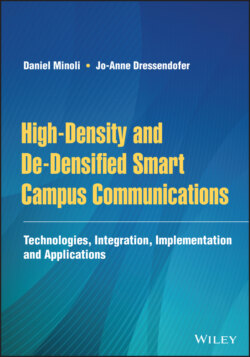Читать книгу High-Density and De-Densified Smart Campus Communications - Daniel Minoli - Страница 24
1.2.9 Pre‐pandemic/Long‐term Requirements for Dense Smart Cities
ОглавлениеCities around the globe are investing in IoT‐based smart city technologies to undertake data‐driven management aimed at improving the administrative and operational processes while ameliorating the quality of life for the residents [17–20]. In 2008, the world's population reached a 50–50 split in the distribution of populations between urban and nonurban environments. At this juncture, one is witnessing an expansion of cities, as populations accelerate the transition from rural and suburban areas into urban areas driven by economic opportunities, demographic shifts, and generational preferences. Seventy percent of the human population is expected to live in cities by the year 2050.
The recent pandemic may impact some of the urbanization trends and dynamics, both on a short‐term basis as well as on a longer‐term basis. For example, on a short‐term basis, ridership in New York City public transportation in March 2020 was down 95%; in August 2020, subway ridership was still down 70% and bus ridership was down 30%. No change in ridership was expected by the authorities at least until early 2021, dependent on the administration of vaccines; face mask mandates and discouraged phone use on public transportation systems. The New York City subway system was shut down 1:00 a.m. to 5:00 a.m. daily for cleaning; bridges and tunnels vehicular traffic into New York City was down 20% from a normal baseline; for NJ Transit, as of beginning of August 2020, ridership was down 65% and authorities were unable to predict when ridership will be back to even 50% [21]. On a longer‐term basis, some have taken a completely pessimistic view about city living (perhaps for political reasons) [22–24], while other have taken a more balanced view, as noted in this 2020 quote [25]:
Tales of Americans fleeing cities in droves, however, are likely overstated. According to … the online real estate service Zillow, 64% of prospective homebuyers on the site are looking at suburban areas – a figure that has barely budged from previous years – while searches for property in rural and urban areas likewise represent about the same percentage as before.
Historically, the largest growth in urban landscapes has been occurring in developing countries. There are now more than 400 cities with over 1 million inhabitants and there are 20 cities with over 10 million people. In most instances, especially in the Western World, cities have aging infrastructures, such as roads, bridges, tunnels, rail yards, and power distribution plants. Some locations have experienced tremendous real estate development in recent years, yet the roads, water mains, sewers, power grids, and sometimes even communication links have seen no, or extremely limited, upgrades. The physical infrastructure that is in place in many cities is aging, and going forward, the services provided by such infrastructure may be subject to temporary rationing as necessary, even emergency upgrades are made. Sometimes, just closing a lane for a few days creates chaotic and dangerous traffic conditions and national headlines.
New technological solutions are being developed to manage the increasingly scarce infrastructure resources, especially in view of the challenges imposed by population growth, limited financial resources, and perennial political inertia. IoT technologies and principles hold the promise of improving the resource management of many assets related to city life, including the flow of goods, the movement of private and public vehicles, and the greening of the environment. Smart Cities application areas include but are not limited to ITSs (including Smart Mobility, vehicular automation, and traffic control), smart grids, smart building, goods and products, logistics (including smart manufacturing), sensing (including crowdsensing and Smart Environments), surveillance/intelligence, and smart services. Cities have been incorporating new technologies over the years, but recently the rate of technology adoption has increased, especially for, but not limited to, surveillance, traffic control, energy efficiency, and street lighting. Many of these IoT technologies require extensive communication infrastructures supporting high density, low latency, and high reliability. For example, ITSs require end‐to‐end latency in the order of milliseconds as well as high density in congested locations. Dense residence neighborhoods require Gbps‐level user experienced data rate [2].
